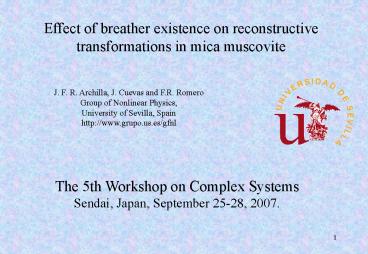Presentacin de PowerPoint - PowerPoint PPT Presentation
1 / 20
Title:
Presentacin de PowerPoint
Description:
Effect of breather existence on reconstructive transformations in mica muscovite ... Cumulative probability and probability density for breathers in mica -- Numerical ... – PowerPoint PPT presentation
Number of Views:58
Avg rating:3.0/5.0
Title: Presentacin de PowerPoint
1
Effect of breather existence on reconstructive
transformations in mica muscovite
J. F. R. Archilla, J. Cuevas and F.R.
Romero Group of Nonlinear Physics, University of
Sevilla, Spain http//www.grupo.us.es/gfnl
The 5th Workshop on Complex Systems Sendai,
Japan, September 25-28, 2007.
2
Reconstructive transformation of muscovite
Muscovite
Disilicate of Lutetium Lu2Si2O7
K2Si6Al2IVAl 4 VIO20(OH)4
Lu3
300 C, 3 days
About 36 of muscovite is transformed
K
3
Reconstructive transformations in layered
silicates
- In the laboratory the long times of ageing are
simulated with higher temperatures - Activation energies range typically about
200-400 kJ/mol - They involve the breaking of the Si-O bond,
stronger than that between any other element and
oxygen and are observed in silicates only above
1000 C - A condition for the transformation to take place
is that sufficient atoms have enough energy to
achieve a transition activated state. - Low temperature reconstructive transformations
(LTRT) in layered silicates have recently been
achieved at temperatures 500 C lower than the
lowest temperature reported before Becerro et
al, J. Mater. Chem 13, (2003) - LTRT take place in the presence of the cation
layer - Possible application in engineered barriers for
nuclear waste in deep geological repositories.
4
Hypothesis 2D breathers within the cation layer
Are their energies larger than the activation
energy? Are there enough number of breathers
to explain the increase in the reaction
rate? Hamiltonian
Harmonic coupling k101 N/m ( D. R. Lide Ed.,
Handbook of Chemistry and Physics, CRC press
2003-2004) On-site potential V Linear frequency
?0143 cm-1 Diaz et al, Clays Clay Miner., 48,
433 (2000)
5
Mean energy of each phonon mode
ltEphgt(n0.5) h?
n1/(e?h? -1) T573 K
Mean phonon energy of about 5 kJ/mol, much
smaller than the activation energy
6
On-site potential obtained from infrared spectrum
Fitting the potential V(x) D ( 1- exp(- b2
x2) ? x6) D 453 cm-1 b2 36 Å-2 ? 49884
cm-1 Å-6
7
Energy density profiles for two soft breathers
?b0.97?0, E 25.6 kJ/mol
?b 0.85 ?0, E 36.3 kJ/mol
?0 167.5 cm-1 51012 Hz
8
Breather frequency versus energy
?0 167.5cm-1 51012 Hz
Mimimum energies ?s 22.4 kJ/mol ?h 240 kJ/mol
Activation energy estimated in 100-200 kJ/mol
BREATHERS HAVE LARGER ENERGIES THAN
THE ACTIVATION ENERGY
9
2D breather statistics Piazza et al, 2003
1.- They have a minimum energy ? 2.- Rate of
breather creation B(E) ? exp (- ?E ),
?1/kBT 3.- Rate of breather destruction D(E) ?
1/(E-?) z Large breathers live
longer. 4.- Thermal equilibrium if Pb(E) dE is
the probability that a breather energy is
between E and EdE D(E) Pb(E) dEA B(E)dE,
A?A(E) 5.- Normalization ?0 Pb(E)
dE1
?
10
Breathers statistics. Results.
- 1.-Pb(E) ?z1 (E- ?)z exp- ?(E- ?)/?(z1)
- 2.- ltEgt?(z1) kBT
- 3.- Most probable energy Ep ? z kBT
- 3.-Fraction of breathers with energy above E
- Cb(E)?(z1)-1 ?(z1, ?E-?)
- 4.- Mean number of breathers per site with energy
above E nb(E)ltnbgtCb(E) - ltnbgtmean number of breathers per site
10-3 - Function gamma and first incomplete gamma
function - ?(z1) ?0 yzexp(-y)dy, ?(z1,x) ?x
yzexp(-y)dy
?
?
11
Probability density and cumulative probability.
Breathers accumulate at higher energies
?
?
12
Numerical simulations in mica. Before cooling.
Random velocities and positions. Thermal
equilibrium. Cooling at the borders.
13
Numerical simulations in mica. After cooling.
14
Multiple types of breathers and
multibreathers. Breathers with maximum
energy. Modification of the theory
15
Cumulative probability and probability density
for
breathers in mica
-- Numerical __ Theoretical
16
Estimations For Ea100-200 kJ/mol, T573 K
_________________
Number of breathers Number of phonons
104-105 (with E? Ea)
Reaction time without breathers 80 a 800 años,
Moreover, breather can loaclize more the energy
delivered, which will increse further the
reaction speed
THERE ARE MUCH LESS BREATHERS THAN LINEAR MODES,
BUT MUCH MORE WITH ENERGYABOVE THE ACTIVATION
ENERGY
17
Other evidences quodons in mica muscovite
- Black tracks Fe3O4
- Cause
- 0.1 Particles
- muons produced by
- interaction with neutrines
- positrons produced by muons electromagnetic
interaction and K decay - 99.9 Unknown
- Lattice localized vibrations quodons?
18
Other evidences Sputtering
Trayectories along lattice directions within the
K layer
Evidence for moving breathers in a layered
crystal insulator at 300K FM Russell y JC
Eilbeck, Europhysics Letters, 78 (2007) 1004
19
- CONCLUSIONS
- 1. Breathers within the cation layer have
larger energies than - the activation energy
- There are much more breathers than linear modes
with enough energy, which can explain the
observed increase in the reaction speed - There are other evidences on the existence of
breather in the cation layer
20
Acknowledgments JFRA to LADIR for hospitality and
the spectra performed. To the Spanish Ministry of
Education and Science, project FIS2004-01183. To
prof. R Livi from Florence University and to
profs. JM Trillo and MD Alba from CSIC for useful
discussions. Bibliography Discrete breathers
for understanding reconstructive mineral
processes at low temperatures, JFR Archilla, J
Cuevas, MD Alba, M Naranjo and JM Trillo, J.
Phys. Chem. B 110 (2006) 24112.































